
Smart Gardening: Identifying the Oaks of Michigan
DOWNLOADAugust 9, 2021 - Mary Wilson and Ruth Dorando Marcy, Michigan State University Extension
There are 600 species of oaks worldwide, 10 of which are native to Michigan. All oaks belong to the genus Quercus, produce acorns and fall into two groups: red oaks and white oaks. Red oaks have leaves with bristle-tipped lobes and acorns that take two years to mature. Northern red oak, black oak, northern pin oak, pin oak and scarlet oak all belong to the red oak group. White oaks have rounded lobes or large regular teeth and acorns that mature in one year. White oak, bur oak, swamp white oak, chinkapin oak and chestnut oak all belong to the white oak group.
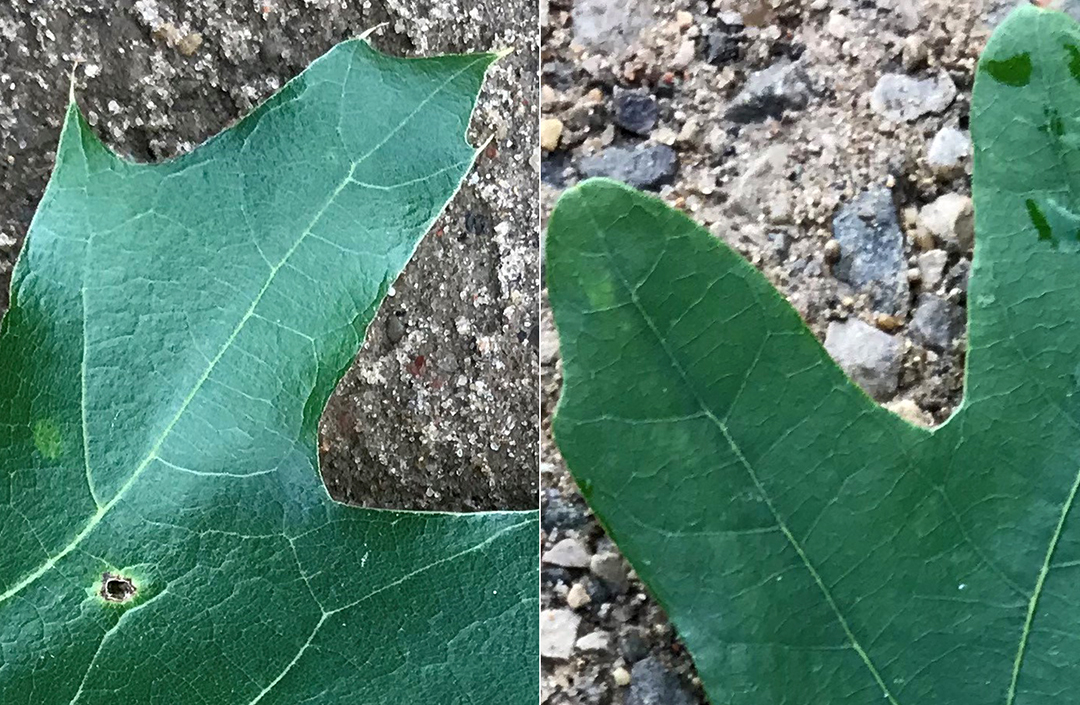
Oaks readily hybridize with other oaks in their groups, producing oaks with characteristics from both species. While this can make identification more complicated, the following guide will help distinguish between the 10 most common species of oaks in Michigan. Familiarize yourself with the terms used to describe leaves with the diagram below.
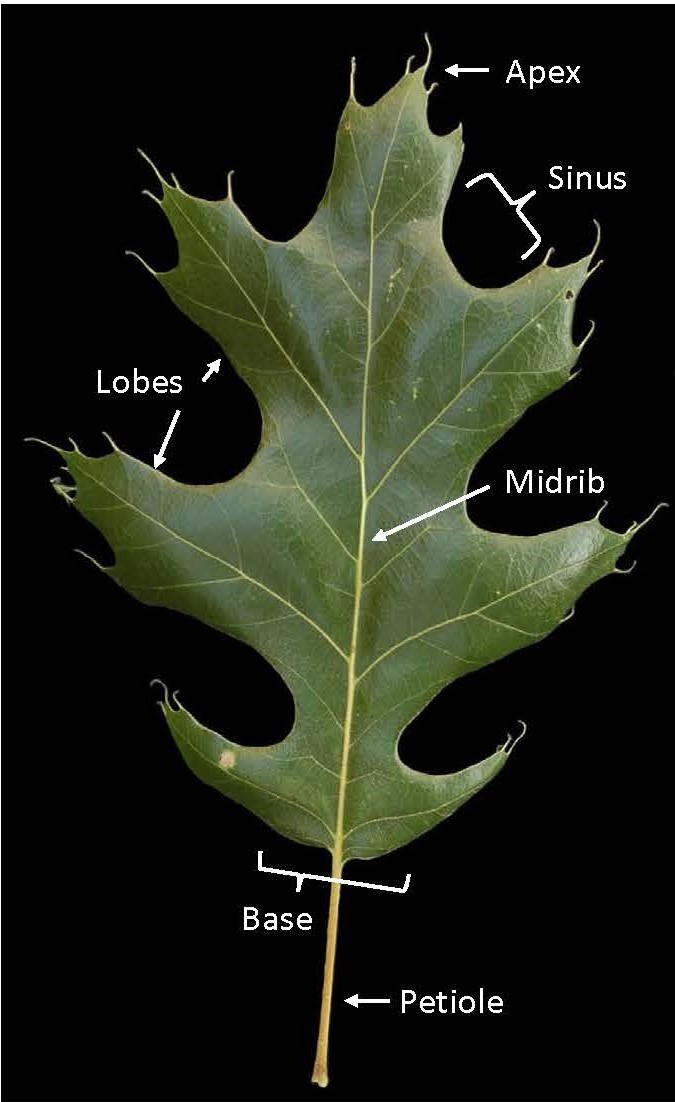
Red oak group
Northern red oak (Quercus rubra) is the most prevalent oak species in Michigan. It can be identified by the 5- to 8-inch-long leaf with seven to 11 bristle-tipped lobes. The leaf is typically dull green above and lighter green below with a smooth, reddish petiole measuring about 1-2 inches long. The sinuses reach less than half-way to the midrib. The acorn is nearly round with a flat, thick cap reminiscent of a beret that covers one-fourth of the nut. The bark is smooth, dark gray when young, becoming furrowed with flat-topped ridges forming stripes when older.
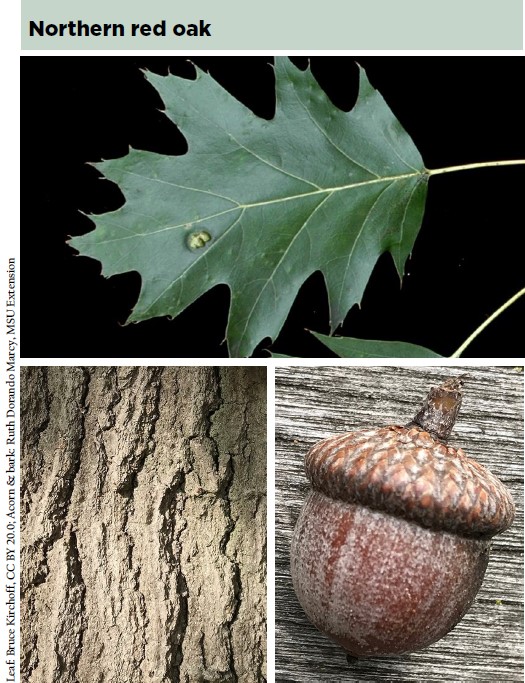
Black oak (Quercus velutina) is the second most prevalent red oak in Michigan. Leaves are 4-10 inches long with mostly five, sometimes seven bristle-tipped lobes. They are shinier than the northern red oak and dark green above with a lighter underside. Leaves have hairs on the underside that are shed later in the season. The acorn nuts are half-covered by caps with loose scales. The caps have rounded interiors, unlike the acorns of the northern red oak, which are flattened. The bark is gray and smooth when young, becoming very dark with deep ridges that have horizontal breaks when older.
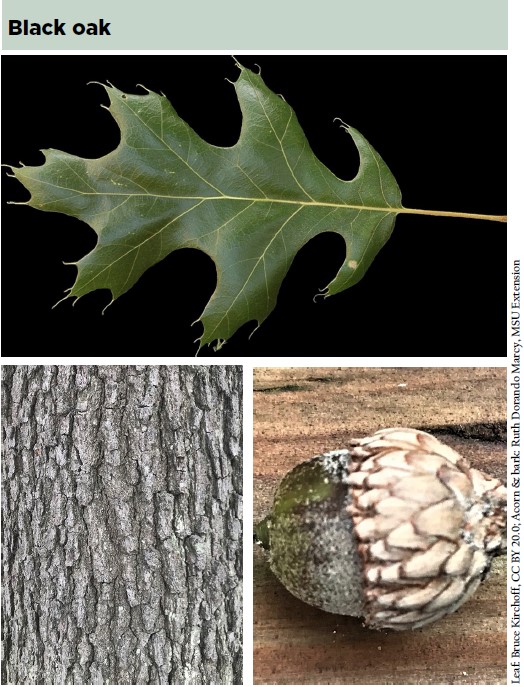
Northern pin oak (Quercus ellipsoidalis) has leaves that are 3-6 inches long, shiny green and widest in the middle, with deeply cut rounded sinuses and a flattish base (Photo 5). They typically have five to seven lobes, though occasionally have nine bristle-tipped lobes. The acorns have caps with loose, fuzzy scales that enclose one-third to one-half of the nut. The bark is shallowly furrowed with narrow vertical plates. Note that northern pin oaks prefer drier locations than pin oaks and fully shed their leaves in the fall, whereas pin oaks retain leaves into winter. Both northern pin oak and pin oak (see below) tend to hang onto their lower branches when those limbs die. This gives the tree a messy, unkempt appearance.
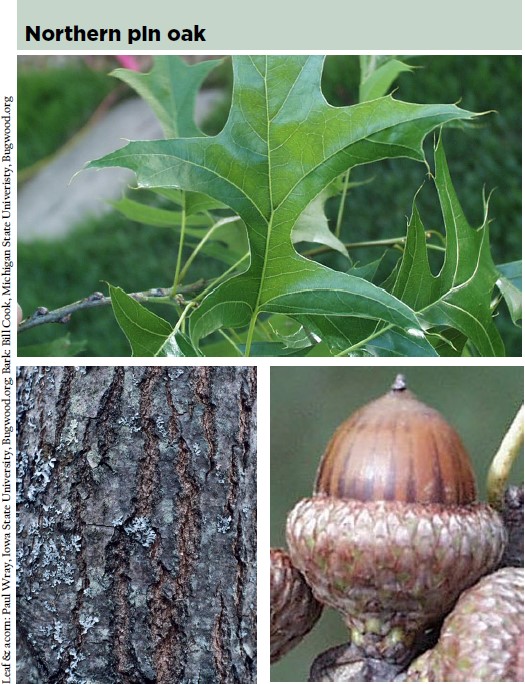
Pin oak (Quercus palustris) has leaves that are 3-6 inches long with five to seven bristle-tipped lobes. The sinuses are typically more deeply cut than in northern pin oak and extend almost to the midrib. The leaf is bright green and can have either a flat or a wedge-shaped base. The acorn is round though flattened at the cap end and often striated. The cap is saucer-shaped, covered with tight scales and encloses one-fourth of the nut. The thin, gray-brown bark remains quite smooth until later in life when it develops ridges and furrows. Pin oaks are less tolerant of higher pH soils than northern pin oaks.
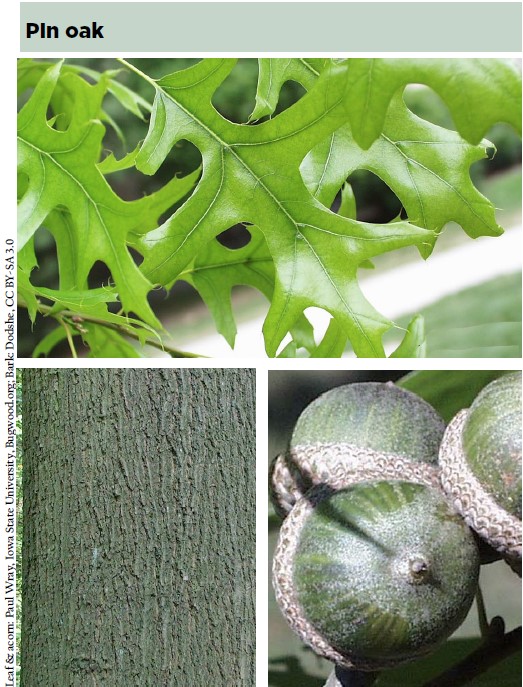
Scarlet oak (Quercus coccinea) is the least common red oak species in Michigan. Its leaves are 3-6 inches long and 3-5 inches wide with seven to nine bristle-tipped lobes. The deep sinuses are rounded so that they form more than half a circle. The leaves are glossy light green and turn scarlet in autumn. The acorn cap has tight fighting scales and encloses one-third to one-half of the nut. The tip of the acorn often has concentric circles or fine cracks. The bark develops broad ridges and narrow furrows; the inner bark is red to orange.
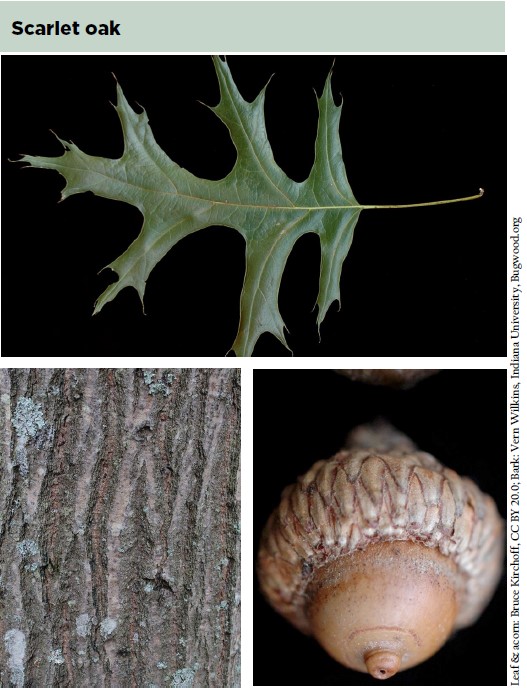
White oak group
White oak (Quercus alba) is the second most numerous oak species in Michigan. They have 4- to 8-inch-long leaves with seven to nine rounded, finger-like lobes. The leaf is widest above the middle and has sinuses that vary from deeply cut to shallower, and is a deep, blue green above and pale green beneath. The apex is rounded and the base is wedge-shaped. The acorns have warty, light gray caps enclosing one-fourth of the oblong nut. They grow singly or in groups on a short stalk. The ashy gray bark has shallow furrows that form scaly plates. The characteristic ashy gray bark color helps to distinguish white oak from other oak species.
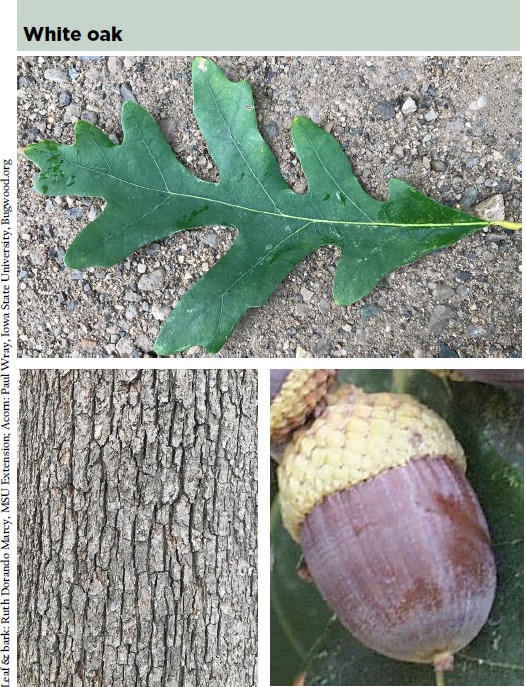
Bur oak (Quercus macrocarpa) is the most common native white oak in North America, and the second most frequently found white oak in Michigan. Its leaves are 3-6 inches long with five to seven rounded lobes that are widest at the center and are dark green above and grayish green and fuzzy beneath. The center sinuses nearly reach the midrib of the leaf. The apex is broad and round, and the base is wedge-shaped. The acorns of this oak are very distinctive, having a deep cup with grayish scales and a fringed bottom edge that encloses more than half of the nut. Due to the acorn’s unique characteristics, this oak is also known as mossycup oak. The bark is rough and deeply furrowed with ridges broken into irregular thick scales.
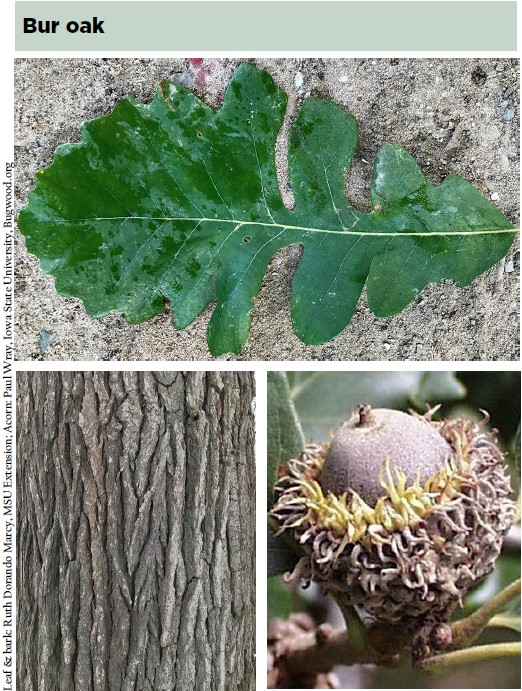
Swamp white oak (Quercus bicolor) leaves are 3-7 inches long, are widest above the middle and have a rounded apex and a wedge-shaped base. There are four to six veins on either side of the midrib, each ending in a shallow lobe or tooth. The upper surface of the leaf is shiny dark green, the lower surface is paler and velvety. The acorns are borne on a longish stalk either singly or in pairs. The bowl-shaped, spiny cap covers about one-third of the nut. The bark is gray and scaly with irregular fissures and ridges.
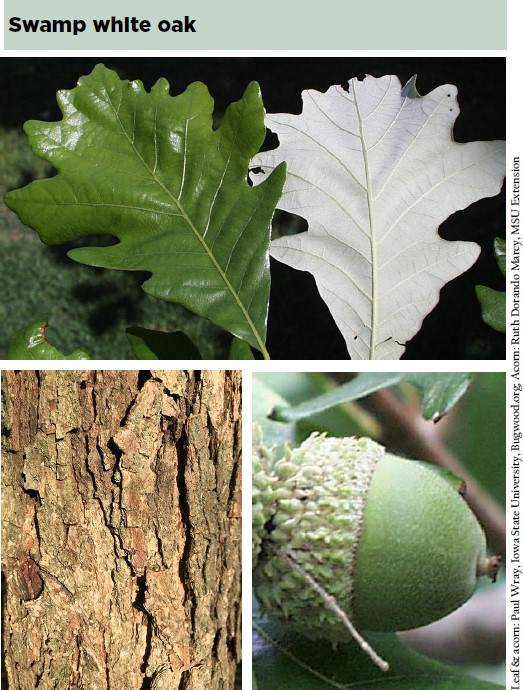
Chinkapin oak (Quercus muehlenbergii) is native to southern lower Michigan. Its leaves are 2-6 inches long, narrow, tapered at both ends and glossy green on top and grayish green and downy beneath. The leaf has numerous (10-15) parallel side veins, each ending in a tooth or shallow lobe. The acorns are borne singly or in pairs on a stalk. The bowl-shaped cap is covered in small, hairy scales and encloses about one-third of the nut with an uneven edge. They are dark brown when mature. The bark is gray, thin and scaly.
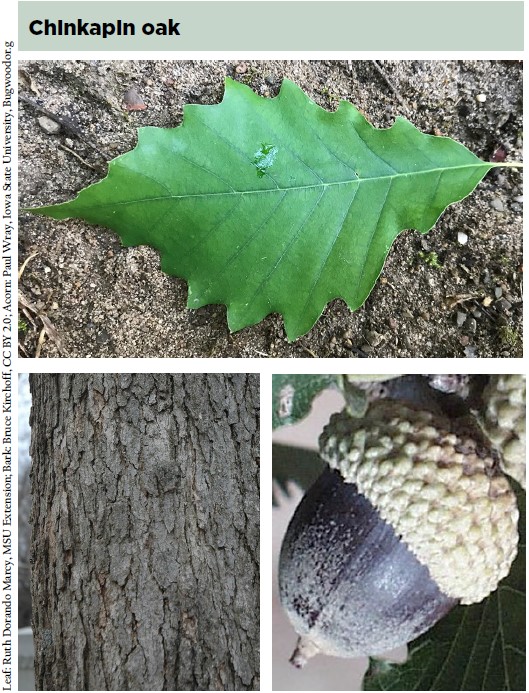
Chestnut oak (Quercus montana) is relatively uncommon in Michigan. These trees are very slow-growing and can live to be 400 years old. Its leaves are similar to chinkapin leaves, but the teeth are more rounded. The petiole is yellow and the leaves are shiny green above and paler below. The acorns are large and ovoid, and the cup is warty with an even edge. The bark is dark with deep V-shaped furrows producing broad ridges.
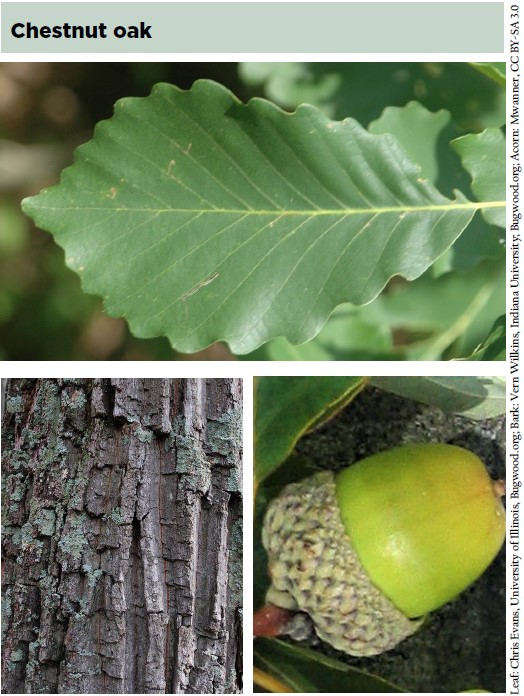
Smart Gardening to prevent oak wilt
For information on oak wilt, a lethal disease infecting many of our Michigan oak trees, please refer to the tip sheet: Smart Gardening to Prevent Oak Wilt.
For more information on a wide variety of Smart Gardening topics, visit www.migarden.msu.edu or call MSU’s Lawn and Garden hotline at 1-888-678-3464.
This publication is supported in part by the Crop Protection and Pest Management Program 2017-70006-27175 from the USDA National Institute of Food and Agriculture. Any opinions, findings, conclusions, or recommendations expressed are those of the author(s) and do not necessarily reflect the view of the U.S.
Department of Agriculture.



 Print
Print Email
Email





